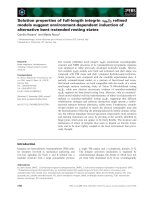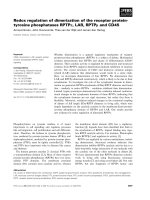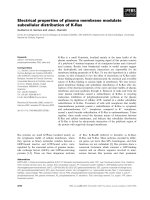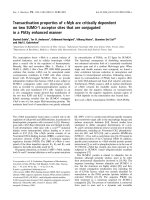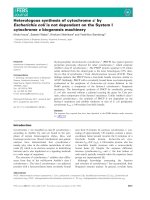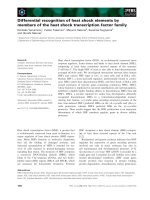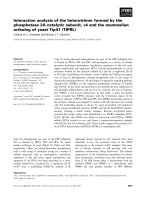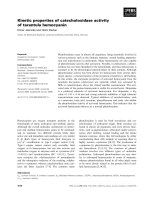Báo cáo khoa học: Redox properties of cytochrome P450BM3 measured by direct methods potx
Bạn đang xem bản rút gọn của tài liệu. Xem và tải ngay bản đầy đủ của tài liệu tại đây (259.48 KB, 7 trang )
Redox properties of cytochrome P450
BM3
measured by direct methods
Barry D. Fleming
1
, Yanni Tian
1
, Stephen G. Bell
1
, Luet-Lok Wong
1
, Vlada Urlacher
2
and H. Allen O. Hill
1
1
Department of Chemistry, Inorganic Chemistry Laboratory, University of Oxford, Oxford, UK;
2
Institute of Technical Biochemistry,
University of Stuttgart, Stuttgart, Germany
Cytochrome P450
BM3
is a self-sufficient fatty acid mono-
oxygenase consisting of a diflavin (FAD/FMN) reductase
domain and a heme domain fused together in a single
polypeptide chain. The multidomain structure makes it an
ideal model system for studying the mechanism of electron
transfer and for understanding P450 systems in general.
Here we report the redox properties of the cyto-
chrome P450
BM3
wild-type holoenzyme, and its isolated
FAD reductase and P450 heme domains, when immobilized
in a didodecyldimethylammonium bromide film cast on
an edge-plane graphite electrode. The holoenzyme showed
cyclic voltammetric peaks originating from both the flavin
reductase domain and the Fe
III
/Fe
II
redox couple contained
in the heme domain, with formal potentials of )0.388 and
)0.250 V with respect to a saturated calomel electrode,
respectively. When measured in buffer solutions containing
the holoenzyme or FAD-reductase domain, the reductase
response could be maintained for several hours as a result of
protein reorganization and refreshing at the didodecyldi-
methylammonium modified surface. When measured in
buffer solution alone, the cyclic voltammetric peaks from the
reductase domain rapidly diminished in favour of the heme
response. Electron transfer from the electrode to the
heme was measured directly and at a similarly fast rate
(k
s
¢ ¼ 221 s
)1
) to natural biological rates. The redox
potential of the Fe
III
/Fe
II
couple increased when carbon
monoxide was bound to the reduced heme, but when in the
presence of substrate(s) no shift in potential was observed.
The reduced heme rapidly catalysed the reduction of oxygen
to hydrogen peroxide.
Keywords: cytochrome P450
BM3
; redox properties; electro-
chemistry.
The cytochrome P450 group of enzymes comprises a
variety of heme-containing monooxygenases that are
present in the majority of prokaryotic and eukaryotic
organisms [1]. The primary reaction catalysed by these
enzymes is the hydroxylation of carbonÆhydrogen bonds.
Substrate hydroxylation requires the activation of dioxy-
gen. The two-electron reducing agent in biological systems
is almost exclusively NAD(P)H, and this reductive activa-
tion of oxygen by P450 occurs in two separate one-electron
additions. The first electron reduces the substrate-bound
ferric heme, facilitating the rapid binding of dioxygen and
the formation of the ferrous–dioxygen intermediate. The
second electron addition, followed by protonation, forms
the ferric hydroperoxy complex. The O–O bond is cleaved,
with one O inserted into the substrate and the other
reduced to form water.
Cytochrome P450
BM3
is a self-sufficient fatty acid mono-
oxygenase found in Bacillus megaterium [2,3]. The native
function of wild-type P450
BM3
is to oxidize long-chain fatty
acids, but it has also been shown to oxidize many other
substrates [4,5]. The 119-kDa molecular mass holoenzyme
has its diflavin (FAD/FMN) reductase domain and heme
domain fused together in a single polypeptide chain, making
the transfer of electrons highly efficient [6]. The multi-
domain structure has made it an ideal model system for
studying the mechanism of electron transfer and for
understanding P450 systems in general [7–10]. Independent
expression of the two domains has permitted their study in
isolation [11].
Redox potentiometric studies have shown the electron
flow for P450
BM3
to follow the path NADPH fi
FAD fi FMN fi heme [12]. The electron flow to the heme
centre in P450
BM3
was presumed to be regulated by a
substrate-dependent increase (> 100 mV) in the redox
potential of the heme, with the ÔsuitabilityÕ of the substrate
for catalytic transformation being reflected in the magnitude
of the increase in potential. Thermodynamic arguments
recently presented by Honeychurch et al. [13], suggested
that the binding of dioxygen to P450
cam
, another essential
step in the P450 catalytic process, would be sufficient to
enable electron cycling, regardless of whether camphor is
present.
Research on the electrochemistry of enzymes is driven
partly by the desire to understand the details of electron
transport in proteins and partly by the great potential uses
of enzymes in electrochemically based biosensors and
bioreactors. Electron transfer between an electrode and
protein was initially accomplished in the pioneering work
of Eddowes & Hill [14] and Yeh & Kuwana [15]. They
showed that the problem of slow electron transfer between
Correspondence to B. D. Fleming, Department of Chemistry,
Inorganic Chemistry Laboratory, University of Oxford,
South Parks Road, Oxford OX1 3QR, UK.
Fax: + 44 1865 272690, Tel.: + 44 1865 275902,
E-mail: barry.fl
Abbreviations: DDAB, didodecyldimethylammonium bromide; EPG,
edge-plane pyrolytic graphite; SCE, saturated calomel electrode.
Enzymes: cytochrome P450 (CYP102, P450
BM3
) (EC 1.14.14.1).
(Received 14 July 2003, revised 19 August 2003,
accepted 21 August 2003)
Eur. J. Biochem. 270, 4082–4088 (2003) Ó FEBS 2003 doi:10.1046/j.1432-1033.2003.03799.x
an electrode and a metalloprotein could be overcome by
use of an electron shuttle or mediator. Since then, much
effort has been directed into developing suitably mediated
or modified electrode systems that facilitate biological
electrochemistry. One such approach is the recently
documented technique of using synthetic surfactant-based
biomimetic membranes [16]. These cast films have been
shown to be useful in attaining direct electrochemistry of
heme-containing proteins [17–22]. In the present work
we employed this method to obtain the direct,
quasi-reversible electrochemistry of the wild-type cyto-
chrome P450
BM3
holoenzyme and its isolated FAD-reduc-
tase and heme domains.
Materials and methods
Enzymes and chemicals
Wild-type cytochrome P450
BM3
was overexpressed in the
Escherichia coli strain, DH5a (that contained the gene of the
wild-type cytochrome P450
BM3
) and the bacterial growth
and protein purification were carried out using published
procedures [23]. The FAD-reductase domain was cloned,
expressed and purified according to published procedures
[24]. The P450
BM3
heme domain was cloned and expressed,
using standard procedures, to encompass amino acid
residues 1–481 of P450
BM3
.TheP450
BM3
heme domain
was purified by DEAE Sepharose and Source-Q anion-
exchange chromatography, as described previously [23].
After purification, fractions with an A
417
/A
280
of > 1 were
collected and stored. All samples were stored at )20 °Cin
40 m
M
phosphate buffer, pH 7.4, containing 50% v/v
glycerol. Glycerol was removed immediately prior to
experiments by gel filtration on a Amersham-Pharmacia
PD-10 column equilibrated with 40 m
M
phosphate buffer,
pH 7.4.
Chemicals and solvents were of reagent grade and used
without further purification unless stated otherwise. Dido-
decyldimethylammonium bromide (DDAB) from Aldrich
was prepared and used as a 0.1-
M
stock solution in
chloroform.
Apparatus and procedures
DC cyclic voltammetry experiments were performed at
room temperature in a standard two-compartment glass cell
with a working volume of 0.5 mL. The working compart-
ment housed the platinum gauze counter electrode in
addition to the edge-plane pyrolytic graphite (EPG) work-
ing electrode. A saturated calomel electrode (SCE) was used
as a reference in a sidearm that connected to the working
compartment via a Luggin capillary. All potentials were
referred to the SCE. An Autolab potentiostat (Eco Chemie,
Utrecht, the Netherlands) was used to record and control
the potential of the working electrode. All measurements
were made in 40 m
M
potassium phosphate buffer, pH 7.4.
Voltammograms were taken in solutions that had been
deoxygenated by purified argon. For buffered protein
solutions this was accomplished by blowing argon over
the solution for several hours. An argon atmosphere was
maintained over the solution during the experiment, unless
stated otherwise.
Preparation of P450/DDAB/EPG electrodes
DDAB films were made by spreading 5 lL of the stock
solution onto a freshly polished EPG electrode. The
chloroform was allowed to evaporate in air at room
temperature for % 1 h. To incorporate the enzyme into
the DDAB-modified electrode, the electrode was either
placed into a solution of protein (% 10 l
M
)for1hat4°C,
or directly into the electrochemical cell containing buffered
protein solution at room temperature.
Results
A typical cyclic voltammogram, recorded for a P450
BM3
–
DDAB-modified EPG electrode in oxygen-free phosphate
buffer, pH 7.4, is shown in Fig. 1. Three cyclic voltammo-
grams are shown: the initial scan soon after electrode
immersion, and then scans after 30 and 60 min. This series
of scans highlights the evolution of the response over a
period of 1 h. Initially, the electrode response was domin-
ated by a well-defined reversible couple centred at )0.388 V,
with a broader, less intense couple observed at )0.250 V.
With time the response at the more negative potential
diminished, whilst the intensity of the other increased, until
after 1 h the current response of the couples, relative to each
other, remained stable (over longer periods of time both
couples decreased at approximately the same rate). A
significant response at )0.250 V could still be observed for
up to 1 week for electrodes maintained in buffer solution at
4 °C. A different result was observed for voltammograms
measured using a DDAB-modified EPG electrode in a
buffered solution of the holoenzyme (Fig. 2). The intensity
of the couple at )0.388 V could be maintained for longer
time-periods(upto3hinthiscase),withaslightincreasein
the signal centred on )0.250 V. When the electrode was
removed from the enzyme solution and placed into enzyme-
free buffer solution, the electrode response observed was
Fig. 1. Cyclic voltammetry of wild-type P450
BM3
holoenzyme immobi-
lized at a didodecyldimethylammonium bromide (DDAB)-modified edge-
plane pyrolytic graphite (EPG) electrode. Cyclic voltammograms were
recorded in deoxygenated phosphate-buffer solution (pH 7.4), at a
scan rate of 0.1 VÆs
)1
, for wild-type P450
BM3
holoenzyme immobilized
at a DDAB-modified EPG electrode after being initially immersed
(darkest line) and then 30 and 60 min (lightest line) later. The arrows
indicate the direction of current change for the respective peaks over
the duration of the experiment.
Ó FEBS 2003 Redox properties of cytochrome P450
BM3
(Eur. J. Biochem. 270) 4083
similar to that shown in Fig. 1. If, after removing the
electrode from the enzyme solution it was stored in buffer
for any length of time, then the response was essentially
dominated by the signal at )0.250 V.
To help identify the origins of the cyclic voltammetric
peaks observed with the holoenzyme, the individual reduc-
tase and heme domains were tested separately. Figure 3
shows that when the FAD-reductase domain was immobi-
lized at a DDAB-coated EPG electrode, quasi-reversible
electrochemistry in buffer was possible. The mid-point
potential of the reductase domain was )0.405 V. As with
the holoenzyme, the reductase domain response diminished
quite rapidly over a period of 1 h when in buffer solution,
but could be maintained for a longer duration when in
protein solution.
A typical cyclic voltammogram recorded for the heme-
domain DDAB-modified EPG electrode in buffer is shown
in Fig. 4. The response consisted of one Faradaic couple
centred on )0.244 V, probably from the Fe
III
/Fe
II
redox
couple. This strong response could be maintained for
many hours and for up to 1 week when the electrode was
maintained in buffer solution at 4 °C. The cyclic voltam-
metric peaks were approximately symmetrical, having
equal areas under both the reductive and oxidative cycle,
and showed a linear current dependence with scan rate
from 0.01 to 1 VÆs
)1
, as expected for thin films of
electroactive species. Using these peak areas, the concen-
tration of the electroactive enzyme at the electrode surface
was calculated to be of the order of nmolesÆcm
)2
. The peak
separation was measured as a function of scan rate for the
Fe
III
/Fe
II
redox couple in both the holoenzyme and the
heme domain. The ÔtrumpetÕ plots, so-formed in this case,
are shown in Fig. 5. Significant peak separation was only
observed when the scan rate exceeded % 10 VÆs
)1
.From
these data, a value for the apparent average electron-
transfer rate constant (k
s
¢) could be calculated. Generally,
k
s
¢ values are obtained from the peak (E
pa
)topeak(E
pc
)
potential separation values in cyclic voltammograms based
on Laviron’s approach for diffusionless thin-layer voltam-
metry [25]. The k
s
¢ value for the Fe
III
/Fe
II
redox couple in
Fig. 2. Cyclic voltammetry of wild-type P450
BM3
holoenzyme in solu-
tion using a DDAB-modified EPG electrode. Cyclic voltammograms
were recorded in a pH 7.4-buffered solution of wild-type P450
BM3
holoenzyme at a scan rate of 0.1 VÆs
)1
for a DDAB-modified EPG
electrode after being immersed for 1 (darkest line), 2 or 3 h (lightest
line), respectively. The arrows indicate the direction of current change
for the respective peaks over the duration of the experiment.
Fig. 3. Cyclic voltammetry of the P450
BM3
FAD-reductase domain
immobilized at a DDAB-modified EPG electrode. The cyclic vol-
tammogram was recorded in deoxygenated phosphate-buffer solution,
pH 7.4, at a scan rate of 0.1 VÆs
)1
for the P450
BM3
reductase domain
immobilized at a DDAB-modified EPG electrode.
Fig. 4. Cyclic voltammetry of the P450
BM3
heme domain immobilized at
aDDAB-modifiedEPGelectrode.The cyclic voltammogram was
recorded in deoxygenated phosphate-buffer solution, pH 7.4, at a scan
rate of 0.1 VÆs
)1
for the P450
BM3
heme domain immobilized at a
DDAB-modified EPG electrode.
Fig. 5. ‘Trumpet’ plots for the heme-domain response. The response
from the P450
BM3
holoenzyme (j)andthehemedomain(m)are
shown. The reductive and oxidative peak potentials are plotted against
thescanrate.Thistypeofplotcanbeusedtocalculatetheelectron
transfer rate constant.
4084 B. D. Fleming et al. (Eur. J. Biochem. 270) Ó FEBS 2003
the holoenzyme and heme domain were determined to be
138 and 221 s
)1
, respectively. The influence of pH on the
heme redox potential, measured by cyclic voltammetry, is
shown in Fig. 6. These data are representative for the
heme response from both the holoenzyme and isolated
heme domain. The mid-point potential became increas-
ingly more negative as the pH was increased from 3 to 10.
Two linear regions of different slopes were observed, one
between pH 3 and pH 8, and the other between pH 8 and
pH 10. The slope of these regions was )33 and
)126 mVÆpH unit
)1
, respectively.
After bubbling the buffer solution with CO for
15 min, the mid-point potential of the heme domain
was positively shifted by 50 mV (Fig. 7). When purged
with argon, the original formal potential returned. The
effect of substrate binding on the redox potential of
the heme domain was also investigated. When any of the
substrates lauric acid, palmitic acid or octane were added
to the buffer solution, there was typically no change in
thecyclicvoltammetricpeaks.
The heme redox couple was very sensitive to the
presence of molecular oxygen. Figure 8 shows the effect,
on the cyclic voltammogram for the heme domain DDAB-
modified EPG electrode, of adding 1, 3 or 5 mL of air into
the buffer solution. A new couple, at a potential slightly
positive of the Fe
III
/Fe
II
couple, was observed. The
reduction of O
2
by ÔbareÕ or DDAB-coated EPG electrodes
occurred at more negative potentials ()0.5 to )0.7 V).
Thus, the presence of the heme significantly lowers the
overpotential required for O
2
reduction. The magnitude of
the reduction peak was related to the amount of O
2
added.
The oxidation peak height was less intense than the
reduction peak, which is characteristic of a mechanism
involving the rapid electrocatalytic reduction of O
2
to
H
2
O
2
by the reduced heme-containing films as per Eqn (1)
and Eqn (2):
P450 Fe
II
þ O
2
! P450 Fe
II
À O
2
ð1Þ
P450 Fe
II
À O
2
þ 2H
þ
þ 2
ee ! P450 Fe
II
þ H
2
O
2
ð2Þ
Discussion
The isolated FAD reductase and heme domains of P450
BM3
have been useful in identifying the voltammetric response
observed with the P450
BM3
holoenzyme. It was clear that
the Faradaic couples centred on )0.388 and )0.250 V had
their origin in the reductase and heme components,
respectively. The peak identification was aided by the fact
that there was no significant shift in potential for the
individual electroactive components compared with when
they were fused together in the holoenzyme. A close
similarity in the redox potential has also been measured
by redox potentiometry for FAD and FMN in the isolated
domains or the P450
BM3
holoenzyme [12]. These solution
measurements were explained in terms of there being no
significant change in the domain environments whether
isolated or fused together. The same could also be said here
of the reductase and heme domains when they are
incorporated in the DDAB film at the electrode surface.
Fig. 6. Influence of pH on the heme redox potential. Cyclic vol-
tammograms at 0.1 VÆs
)1
for wild-type P450
BM3
holoenzyme were
measured at different pH values. The mid-point potentials observed for
each voltammogram were plotted against pH. A similar trend was
observed for the isolated heme domain.
Fig. 7. The effect of CO binding on the P450
BM3
heme redox potential.
Cyclic voltammograms were recorded in deoxygenated phosphate-
buffer solution (at pH 7.4), before and after bubbling with CO for
15 min, at a scan rate of 0.1 VÆs
)1
for the P450
BM3
heme domain
immobilized at a didodecyldimethylammonium bromide (DDAB)-
modified EPG electrode. Peaks shifted to the right in the presence of
CO.
Fig. 8. The effect of O
2
binding on the electrochemistry of the P450
BM3
heme domain. Cyclic voltammograms were recorded in a phosphate-
buffer solution, pH 7.4, after adding 0, 1, 3 or 5 mL of air, at a scan
rate of 0.1 VÆs
)1
for the P450
BM3
heme domain immobilized at a
DDAB-modified EPG electrode. The height of the reduction peak
increased with the amount of air injected into the solution.
Ó FEBS 2003 Redox properties of cytochrome P450
BM3
(Eur. J. Biochem. 270) 4085
The change in the peak intensities for the holoenzyme,
when measured in enzyme-free buffer solution, is of
particular interest and several explanations are considered.
First, some reorganization at the electrode/solution inter-
face, presumably within the DDAB film, had taken place.
The initially large response from the reductase domain
indicates that it is preferentially bound/oriented closest to
the electrode surface. The further development of the
electrode response, lowering of the reductase peak vs.
increase of the heme peak, indicates that this orientation
may be reversed, with the enzyme seemingly rotating to
allow the heme domain to take up a more favourable
electron transfer position near the electrode surface. It is
also possible that the short-lived response in buffer is caused
by denaturation at the electrode surface. This is suggested
by the results observed with the isolated reductase domain.
Its response, both in the presence of protein and in buffer
only, was similar to that for the holoenzyme (except for the
heme component). When the reductase domain is present in
solution, it is plausible that the surface can be refreshed,
effectively replacing the denatured protein. This could
account for the longer duration of the large Faradaic
currents observed. When the protein is not present in
solution, denaturation takes place with no ÔrefreshmentÕ of
the electrode surface and hence the relatively rapid decrease
in current.
With bare EPG electrodes, the direct electron transfer to
P450
BM3
is slow and often not observed. The heme group is
deep within the protein structure and favourable orientation
at the electrode surface must occur to ensure electron
transfer. When incorporated into the surfactant layer, the
direct, rapid and quasi-reversible electron transfer between
the P450 heme and electrode was observed. The P450 heme
redox potential measured here (in both the holoenzyme and
the heme domain only) is of a similar value to previous
measurements for other P450 enzymes and heme-containing
proteins incorporated in DDAB films [16,17,21,22]. The
broadness of the heme peak is considered to be caused by
dispersion of E° values resulting from slight variations in
protein orientation at the electrode surface [17]. The
differences in broadness between the reductive and oxidative
waves, evident in Figs 3 and 4, is typically the result of
nonideality observed with thin-film systems [26]. The
potential of the heme Fe
III
/Fe
II
redox couple ()0.252 V)
was much more positive than that measured in solution
()0.609 V) [12]. This type of behaviour has been reported
for all cases where DDAB has been present as the
biomimetic membrane. This is the result of interactions
between the protein and surfactant and/or surfactant-
related electrical double-layer effects on electrode potential.
This effect was also evident, albeit to a lesser extent, with the
reductase response.
Our results show that the process of immobilization
provides a very favourable environment for electron transfer
to the heme to occur. The k
s
¢ values calculated for the P450
heme domain (% 200 s
)1
) were similar in magnitude to the
k
s
¢ value measured for the natural electron transfer process –
that between the FMN and heme for the P450
BM3
holoenzyme in solution (223 s
)1
with myristate) [7]. These
electron transfer results were dependent on the nature of the
substrate – with the less favoured substrate lauric acid
showing a lower k
s
¢ value of 130 s
)1
. It has also been shown
that it takes more energy to transfer an electron to the P450
heme when no substrate is bound [12]. Our results are all the
more interesting given that no substrate was present. Other
k
s
¢ values for heme-containing proteins, measured using
electrode systems, are well below those reported here for the
P450
BM3
heme domain. For example, P450
cam
in a DDAB
film on a PG electrode was 25 s
)1
[17], whilst a variety of
modified PG electrodes containing myoglobin showed k
s
¢
values ranging from 27 to 86 s
)1
[27].
The pH-dependent potential change observed in Fig. 6
has been shown previously for other heme-containing
proteins immobilized at electrode surfaces [18,19,22,27–
30]. However, in contrast to these previously published data,
the slopes measured in this study for the linear regions were
both quite different to the )59 mVÆpH unit
)1
expected for a
reversible one-electron transfer coupled to a single proton
transfer. A similar low-slope region has also been reported
for myoglobin and hemoglobin in polyacrylamide films, but
this was for pH values of < 5, a region where protein
integrity might be questioned [27,28].
Previous redox potentiometry experiments on P450
BM3
showed that the presence of a suitable substrate results in
an anodic (or positive) shift in redox potential in excess of
100 mV [12]. A similar substrate-dependent anodic shift
was reported for P450
cam
from electrochemical data [31].
Our results indicate that no shift occurs in the formal
potential of heme when in the presence of the substrates
lauric acid, palmitic acid or octane. Similar results, based
on cyclic voltammetric data, were reported recently for
P450
cam
and P450
cin
in the presence of their natural
substrates, camphor and cineole, respectively [22,32]. The
work with P450
cin
employed a similar procedure for
enzyme immobilization as reported in this work [22].
Interestingly, redox potentiometric data for P450
cin
also
showed no indication of a substrate-dependent anodic
shift. There are reasonable thermodynamic arguments to
suggest that substrate binding is not the only or main
consideration in determining whether electron transfer to
P450 will occur [13].
CO is known to rapidly bind specifically as a sixth ligand
to the reduced heme iron of P450
BM3
[33]. The fact that
addition of CO to the buffer solution in our electrochemical
experiments resulted in a peak shift of 50 mV confirmed
that the observed response is from the heme domain.
Similar results were obtained for P450
cam
immobilized at a
DDAB-modified PG electrode [17] and a glassy carbon
electrode modified with sodium montmorillonite [32].
For catalytic reactions involving P450 enzymes, the
reduction of molecular oxygen to reactive oxygen species,
such as H
2
O
2
, is typically an unwanted occurrence which
dramatically reduces the efficiency of the desired catalytic
process. As shown in Fig. 8, once generated, the ferrous
heme rapidly binds dioxygen, but unfortunately catalytic
reduction to H
2
O
2
usually quickly follows. The real
challenge then, in any development of electrode-based
bioreactors designed to utilize the monooxygenase capabi-
lities of P450, is getting the second electron to be used in
peroxoiron complex formation and not in H
2
O
2
dissoci-
ation. Several groups have recognized the difficulties
associated with overcoming this problem and have attemp-
ted to utilize mediator-promoted and H
2
O
2
-driven
pathways to achieve their desired oxidation reactions
4086 B. D. Fleming et al. (Eur. J. Biochem. 270) Ó FEBS 2003
[30,34,35]. Given the fast electron transfer rates and low
potentials necessary for the first electron reduction of the
P450
BM3
heme domain in this surfactant-electrode ensem-
ble, it follows that it should be the subject of ongoing study,
as in our laboratory. However, it remains to be seen whether
an effective electrochemically driven bioreactor, fully utili-
zing Nature’s enzyme technology, can be achieved.
Conclusions
We determined the redox properties of cyto-
chrome P450
BM3
by direct electrochemistry. The holo-
enzyme response at a DDAB-modified EPG electrode was
characterized by redox couples at )0.388 V and )0.250 V.
These were identified as being direct electron transfer to the
individual flavin reductase domain and P450 heme domain,
respectively. We have also shown that, although electron
transfer in the biological system is from FAD/FMN to the
heme, electron transfer can occur directly from the electrode
to the heme under electrochemical conditions. The rate of
this electron transfer is very rapid, of the order of the rates
observed in the natural donor system. The redox potential
of the heme did not appear to be affected by substrate
binding, but it was possible that substrate inclusion in the
surfactant layer may alter the surrounding charge environ-
ment experienced by the protein. The reduction of mole-
cular oxygen was readily catalysed by the P450
BM3
heme domain immobilized at the DDAB-modified elec-
trode.
Acknowledgements
We would like to thank the European Union for the collaborative
grant. We also thank ECEnzymes, BASF and Dr T. Habicher.
References
1. OrtiZ de Montellano, P.R. (1995) Cytochrome P450: Structure,
Mechanism and Biochemistry, 2nd edn. Plenum Press, New York.
2. Narhi, L.O. & Fulco, A.J. (1986) Characterization of a catalyti-
cally self-sufficient 119,000-dalton cytochrome P-450 mono-
oxygenase induced by barbiturates in Bacillus megaterium. J. Biol.
Chem. 261, 7160–7169.
3. Ravichandran, K.G., Boddupalli, S.S., Hasemann, C.A., Peter-
son, J.A. & Deisenhofer, J. (1993) Crystal structure of hemopro-
tein domain of P450BM-3, a prototype for microsomal P450s.
Science 261, 731–736.
4. Guengerich, F.P. (2001) Common and uncommon cytochrome
P450 reactions related to metabolism and chemical toxicology.
Chem.Res.Toxicol.14, 611–650.
5. Guengerich, F.P. (2002) Cytochrome P450 enzymes in the
generation of commercial products. Nat. Rev. Drug Discov. 1,
359–366.
6. Narhi, L.O. & Fulco, A.J. (1987) Identification and character-
ization of two functional domains in cytochrome P-450BM-3, a
catalytically self-sufficient monooxygenase induced by barbitu-
rates in Bacillus megaterium. J. Biol. Chem. 262, 6683–6690.
7. Munro, A.W., Daff, S., Coggins, J.R., Lindsay, J.G. &
Chapman, S.K. (1996) Probing electron transfer in flavocyto-
chrome P-450 BM3 and its component domains. Eur. J. Biochem.
239, 403–409.
8. Sevrioukova, I.F., Hazzard, J.T., Tollin, G. & Poulos, T.L. (1999)
The FMN to heme electron transfer in cytochrome P450BM-3.
J. Biol. Chem. 274, 36097–36106.
9. Sevrioukova, I.F., Li, H., Zhang, H., Peterson, J.A. & Poulos,
T.L. (1999) Structure of a cytochrome P450-redox partner
electron-transfer complex. Proc. Natl Acad. Sci. USA 96, 1863–
1868.
10. Munro, A.W., Leys, D.G., McLean, K.J., Marshall, K.R., Ost,
T.W.B., Daff, S., Miles, C.S., Chapman, S.K., Lysek, D.A.,
Moser, C.C., Page, C.C. & Leslie Dutton, P. (2002) P450 BM3: the
very model of a modern flavocytochrome. Trends Biochem. Sci.
27, 250–257.
11. Miles, J.S., Munro, A.W., Rospendowski, B.N., Smith, W.E.,
McKnights, J. & Thomson, A.J. (1992) Domains of the catalyti-
cally self-sufficient cytochrome P-450 BM-3. Genetic construction,
overexpression, purification and spectroscopic characterisation.
Biochem. J. 288, 503–509.
12. Daff, S.N., Chapman, S.K., Turner, K.L., Holt, R.A., Govinda-
raj, S., Poulos, T.L. & Munro, A.W. (1997) Redox control of the
catalytic cycle of flavocytochrome P-450 BM3. Biochemistry 36,
13816–13823.
13. Honeychurch, M.J., Hill, H.A.O. & Wong, L L. (1999) The
thermodynamics and kinetics of electron transfer in the cyto-
chrome P450cam enzyme system. FEBS Lett. 451, 351–353.
14. Eddowes, M.J. & Hill, H.A.O. (1977) Novel method for the
investigation of the electrochemistry of metalloproteins: cyto-
chrome c. J. Chem. Soc., Chem. Commun. 21, 771–772.
15. Yeh, P. & Kuwana, T. (1977) Reversible electrode reaction of
cytochrome c. Chem. Lett. 10, 1145–1148.
16. Rusling, J.F. & Nassar, A E.F. (1993) Enhanced electron transfer
for myoglobin in surfactant films on electrodes. J. Am. Chem. Soc.
115, 11891–11897.
17. Zhang, Z., Nassar, A E.F., Lu, Z., Schenkman, J.B. & Rusling,
J.F. (1997) Direct electron injection from electrodes to cytochrome
P450
cam
biomembrane-like films. J. Chem. Soc., Faraday Trans.
93, 1769–1774.
18. Rusling, J.F. (1998) Enzyme bioelectrochemistry in cast bio-
membrame-like films. Acc. Chem. Res. 31, 363–369.
19. Chen, X., Hu, N., Zeng, Y., Rusling, J.F. & Yang, J. (1999)
Ordered electrochemically active films of hemoglobin,
didodecylmethylammonium ions, and clay. Langmuir 15, 7022–
7030.
20. Boussaad, S. & Tao, N.J. (1999) Electron transfer and adsorption
of myoglobin on self-assembled surfactant films: an electro-
chemical tapping-mode AFM study. J. Am. Chem. Soc. 121,
4510–4515.
21. Koo, L.S., Immos, C.E., Cohen, M.S., Farmer, P.J. & OrtiZ de
Montellano, P.R. (2002) Enhanced electron transfer and lauric
acid hydroxylation by site-directed mutagenesis of CYP119.
J. Am. Chem. Soc. 124, 5684–5691.
22. Aguey-Zinsou, K F., Bernhardt, P.V., De Voss, J.J. & Slessor,
K.E. (2003) Electrochemistry of P450cin: new insights into P450
electron transfer. Chem. Commun. 3, 418–419.
23. Carmichael, A.B. & Wong, L L. (2001) Protein engineering of
Bacillus megaterium CYP102. The oxidation of polycyclic
aromatic hydrocarbons. Eur. J. Biochem. 268, 3117–3125.
24. Sevrioukova, I., Truan, G. & Peterson, J.A. (1996) The flavo-
protein domain of P450BM-3: expression, purification, and
properties of the flavin adenine dinucleotide- and flavin mono-
nucleotide-binding subdomains. Biochemistry 35, 7528–7535.
25. Laviron, E. (1979) General expression of the linear potential sweep
voltammogram in the case of diffusionless electrochemical sys-
tems. J. Electroanal. Chem. 101, 19–28.
26. Armstrong, F., Heering, H.A. & Hirst, J. (1997) Reactions of
complex metalloproteins studied by protein-film voltammetry.
Chem. Soc. Rev. 26, 169–179.
27. Shen, L., Huang, R. & Hu, N. (2002) Myoglobin in poly-
acrylamide hydrogel films: direct electrochemistry and electro-
chemical catalysis. Talanta 56, 1131–1139.
Ó FEBS 2003 Redox properties of cytochrome P450
BM3
(Eur. J. Biochem. 270) 4087
28. Sun, H., Hu, N. & Ma, H. (2000) Direct electrochemistry of
hemoglobin in polyacrylamide films on pyrolytic graphite elec-
trodes. Electroanalysis 12, 1064–1070.
29. Lei, C., Wollenberger, U., Bistolas, N., Guiseppi-Elie, A. &
Scheller, F.W. (2002) Electron transfer of hemoglobin at electro-
des modified with colloidal clay nanoparticles. Anal. Bioanal.
Chem. 372, 235–239.
30. Munge, B., Estavillo, C., Schenkman, J.B. & Rusling, J.F. (2003)
Optimisation of electrochemical and peroxide-driven oxidation of
styrene with ultrathin polyion films containing P450cam and
myoglobin. ChemBioChem. 4, 82–89.
31. Kazlauskaite, J., Westlake, A.C.G., Wong, L L. & Hill, H.A.O.
(1996) Direct electrochemistry of cytochrome P450cam. Chem.
Commun. 18, 2189–2190.
32. Lei, C., Wollenberger, U., Jung, C. & Scheller, F.W. (2000) Clay-
bridged electron transfer between cytochrome P450cam and
electrode. Biochem.Biophys.Res.Commun.268, 740–744.
33. Sevrioukova, I.F. & Peterson, J.A. (1995) Reaction of
carbon monoxide and molecular oxygen with P450terp (CYP108)
and P450BM-3 (CYP102). Arch. Biochem. Biophys. 317,
397–404.
34. Faulkner, K.M., Shet, M.S., Fisher, C.W. & Estabrook, R.W.
(1995) Electrocatalytically driven x-hydroxylation of fatty acids
using cytochrome P450 4A1. Proc. Natl Acad. Sci. USA 92, 7705–
7709.
35. Reipa, V., Mayhew, M.P. & Vilker, V.L. (1997) A direct electrode-
driven P450 cycle for biocatalysis. Proc. Natl Acad. Sci. USA 94,
13554–13558.
4088 B. D. Fleming et al. (Eur. J. Biochem. 270) Ó FEBS 2003
